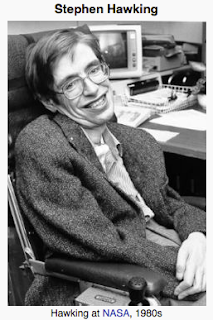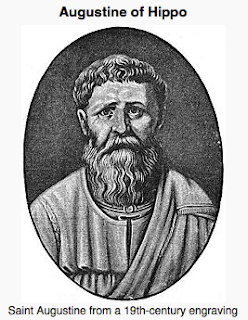Part 9: The Physics of Heaven*
A Serial Book Review & Theological Interaction
 |
| “The God Vibration” author Dan McCollam at School of the Prophets |
By Pastor Larry DeBruyn
Review of Chapter 8 (authored by Dan McCollam)
“The God Vibration”[1]
19:1-4) God’s voice and the sound of angels can also be heard and
experienced by man. A whole new realm of encounter awaits those who
possess three simple qualities: expectancy, intentionality, and
intimacy. Because God, creation, and the angels are constantly
interacting, we can expect to hear from them at times.
—Dan
McCollam (TPOH, 85)
Introduction
In a dialectic three step, Dan McCollam dances with deception as he first accepts the Genesis account of creation (no other step need be taken), then synthesizes that account with quantum physics and finally, promotes contemplative spirituality or mysticism as the way to encounter the supernatural realm.[2] In this chapter the author weaves together a combination of Scripture, science and supernaturalism.
Scripture
In his chapter “The God Vibration,” the author employs the Bible to explain the origin of the universe. God the Father, as the opening verses of Genesis state, created “something out of nothing.” (TPOH, 79) To buttress the creation account, McCollam refers to the writings of creation scientist Dr. Henry Morris (1918-2006).[3] He also accepts that the Son is the Creator (John 1:3; 1 Corinthians 8:6; Colossians 1:16; Hebrews 1:2), and that “by” Christ the universe coheres or holds together (Colossians 1:17b). But then he injects physics into the explanation of origins. As the chapter’s preface states, Modern scientific discoveries have recently joined the voice of ancient sacred writings to pull back the veil of ignorance that once shrouded the power of sound in God’s universe.(TPOH, 77)
Science
For example, McCollam defines the action of Holy Spirit’s “moving [or] hovering over the surface of the waters” as “vibrating,” a meaning he imports from quantum physics (Genesis 1:2). The author states: “Therefore it could be said that the Holy Spirit vibrated over the formless universe” even as he proceeds to add, “Vibrations are the forces that hold particle matter together.”(TPOH, 79-80) These continuing vibrations of the Spirit of God McCollum associates with string theory; that theory of quantum physics which proposes that, “there are tiny vibrating strands of energy at the center of all matter.”(TPOH, 81)
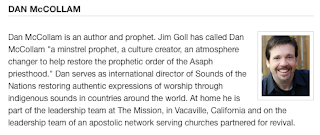 |
| McCollam’s bio at Bill Johnson’s Bethel website “School of the Prophets” |
McCollam constructs this theory from the Hebrew word used to describe the Holy Spirit as “hovering” (i.e., rachaph) over the dead and dark material mass God had spoken into existence ex nihilo, out of nothing. The author states “hovering” can mean “vibrating” despite the fact that in its only other occurrence in the Old Testament the rare verb pictures an eagle providentially caring for its young eaglets by guarding the nest (Deuteronomy 32:11). So rachaph pictures God’s Spirit protectively hovering “over the surface of the waters” as God (the Father and the Son) was about to energize matter with light and fill the void of an otherwise empty universe.
For McCollam it might be assessed that the Genesis narrative provides the “frame” for his understanding of origins which he then “fills” with inferences extracted from the science of quantum physics (i.e., that the material universe is filled with “vibrations” infused in it by God).[4] As he states, “Quantum physics serves as one of the great scientific disciplines bridging the river of confusion between science and biblical kingdom thinking.”(TPOH, 77) But McCollam does not stop there.
Supernaturalism
In taking his quantum leap of faith and providing a platform for pursuing mysticism, McCollam proposes that “God… and the angels are constantly interacting” with a vibrating universe and then proceeds to advocate readers get in on the action by opening their hearts, eyes and ears with “an expectancy to encounter the sounds and sights of heaven on a new level.”(TPOH, 85) Openness to the vibrating oneness of reality, says the author, will breed the spiritual “intimacy” necessary to incubate “increased encounters from the supernatural realm.”(TPOH, 86) So vibrations become the focal point for contacting and encountering nature (of which all earth-bound persons like us are a part) or super-nature (the realm inhabited by God, angels, Satan, demons, Nephilim, space aliens, familial spirits or whatever other invented entities or mythological deities are believed to inhabit and traverse throughout the universe). But how does one make the “contact” to connect with the supernatural beings inhabiting the universe’s upper story or outer space? According to the author, the devout can generally do so by cultivating the right attitudes and taking the proper action.[5]
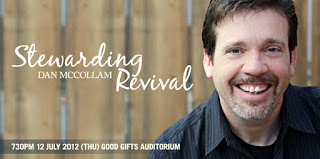 |
| McCollam at a NAR-related website: http://www.reva.org.sg/author/jamestan/ |
Panentheism and Process
So my problem with the worldview McCollam creates does not lie in the references he makes to the Genesis creation—though I think, as has been pointed out, his interpretation is off on some points—but with his enhancing the Scriptural account by integrating speculative science into it.[6] (“Everything in the universe has a vibration at the center of it.”—TPOH, 84). All creation therefore becomes animated with and permeated of the vibrations of God. This oneness worldview is panentheistic and resembles that of process theologians.[7] Both systems of spirituality and thought incorporate God into the being (permeation of divine vibrations throughout the universe—i.e., panentheism) and becoming (divine interaction with that energy—i.e., process) of the universe. Both understandings sacrifice God’s transcendence upon the altar of “His immanence,” which becomes the seedbed of idolatry. In his dedicatory prayer for the Temple, Solomon steered clear of the idea of oneness (1 Kings 8:27; 2 Chronicles 2:6; Compare Isaiah 66:1.). The universe is not God’s “container.” While God is omnipresent throughout, He does not omnipermeate the universe.
Though energy may help us to understand reality, it does not explain, I believe, the entire complex in which “we live, move and have our being” Acts 17:28a, KJV). By itself, light or energy reveal nothing to us about God’s plan of divine redemption for both a fallen humanity and creation.
So in our acceptance of the Genesis account as well other points regarding creation, I agree with the author. But despite some agreement, there resides a “quantum” difference regarding our understanding of and spiritual experience in the reality we know as “life.” In short, by reading speculative science into the understanding of God’s Word and then seeking confirmation of the synthesis by adventuring into speculative spirituality, McCollam undermines the sufficiency of Holy Scripture.
We turn to look at the mystic way the author promotes at the end of the chapter.
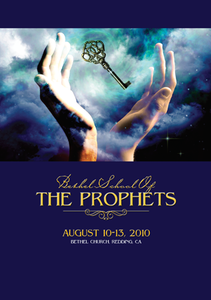 |
| McCollam at a 2010 School of the Prophets |
The Mystic Way
1. Anticipation
First, anticipate . . . “Open your heart, your eyes, and your ears with the expectancy to encounter the sounds and sights of heaven on a new level,” counsels McCollam.(TPOH, 85) To experience whatever “vibrations” might be “out there,” Christians must make preparations “down here.” They must break away from their old spiritual past (traditional paths to spirituality like Bible reading, prayer, the Apostle’s teaching, fellowship with other believers, and observing the Lord’s Table) in order to experience a new spiritual future, to encounter the “vibrations” of the supernatural realm in new ways. “Expect it” if you want to “get it”! McCollam writes that, “God wants to broadband your ability to receive from Him.”[8](TPOH, 85-86) So at the vibrating quantum level of reality, God “delights” to interact with His children even as He interacts with that reality Himself. So to this end, both “faith and expectancy create an environment for encounter.”(TPOH, 86) But the believer is not to stand idly by and wait for encounters to just happen (though mystics teach that encounters can be spontaneous). Illuminations may unexpectedly happen.
Phony Glory
In his chapter titled “The Luminous Phenomena of Mysticism” from his book The Physical Phenomena of Mysticism, Herbert Thurston, S.J., notes “the frequent occurrence of luminous phenomena in mediumistic séances” which then inclines him to think “that similar manifestations are not likely to be lacking in the records of mysticism.”[9] Then the fact of the similarity between the miracles of Moses and the counterfeits performed by Pharaoh’s magicians leads Thurston to therefore observe that,
No careful student of physical research can fail to notice a very close resemblance between the marvels recorded in the lives of Saints, and the phenomena of what is loosely termed spiritualism.[10]
Though on this point I do not think Thurston was indicting the mysticism of the saints to be spiritualism, his analogy does beg the question about PSI phenomena, which authors in The Physics of Heaven advocate experiencing, “How can anyone definitively discern which is which?” Reader: Connect the dots. Even Satan himself is disguised as an angel of light and we therefore should not be surprised that his ministers are likewise (2 Corinthians 11:14). So expectancy can end in fantasy and deception, or worse.
 |
| McCollam advertised on TheElijahList, 2/17/11, http://elijahlist.com/words/display_word/9595 |
2. Initiation
Second, initiate . . . Encounters are not accidental. Activity, not passivity, is the key to experience the “God vibration” or the sights and sounds of the supernatural realm. Heaven can come down to earth, and devout souls can make that happen. So Christians must develop intentionality if they are to experience the supernatural realm. “Intentionality is simply the decision to see and listen.”(TPOH, 86) “Activate your sensitivity to your aural and spiritual environment,” suggests McCollam, and then adds, “When you suspect a unique sound or light encounter—follow it.”(TPOH, 86) (Ed. Note: In other words, pay no attention to the Apostle Paul’s notice that, “Satan disguises himself as an angel of light”—2 Corinthians 11:14). Though the author does not directly use either the verbs contemplate or meditate, he repackages the activity with the advice to “activate your sensitivity to your aural and spiritual environment phrase.” So to activate, Christians might be encouraged to contemplate. This initiatory mystical practice has been around the church for fifteen centuries plus and produced physical phenomena—what the author would call “encounters”—from the supernatural realm.[11] Of the relationship between contemplative or meditative prayer, paranormal expert Rosemary Guiley notes that often,
Psychic phenomena and powers are associated with prayer and meditation. The literature of Western mystics describes clairvoyance, clairaudience, levitation, precognition, prophecy, and so on as unsought by-products of mystical prayer.[12]
After referring to clairvoyance experienced by St. Anthony (1195-1231) and levitations by St. Francis of Assisi (1181-1226) and St. Joseph of Cupertino (1603-1633)—“who could ‘fly’ short distances and stay aloft for a considerable time”—Guiley remarks that, “Such phenomena may be compared to the siddhis of Eastern meditation and yoga.”[13]
On this point it should be noted that Jonathan Welton, another author in a chapter in The Physics of Heaven, has stated:
I have found throughout Scripture at least 75 examples of things that the New Age has counterfeited, such as having a spirit guide, trances, meditation, auras, power objects, clairvoyance, clairaudience, and more. These actually belong to the church, but they have been stolen and cleverly repackaged.(TPOH, 49)
 |
|
|
3. Cultivation
Third, remain sensitive . . . Because “encounters are born out of intimacy,” Christians need to keep their hearts sensitive and humble before God. At the slightest hint that God might be vibrating a message to or an encounter with them, they need to cease what they are doing and “turn aside with Him even if just for a moment.”(TPOH, 86) To this end, Christians need to continually “cultivate a sense of the Lord’s presence” in their everyday life for “Intimacy is the incubator of increased encounters from the supernatural realm.”(TPOH, 86).
This raises the question, “Intimate encounters with what?” The realm of spirits, whether angelic and demonic, is real. Seeking intimacy with supernatural entities, whatever they might be, is unscriptural. Never are we told in the Bible to seek intimacy with angels. Furthermore, Scripture tells believers, in light of the spiritual conflict they are in, to “Resist the devil” (James 4:7) and not give him “opportunity” (Ephesians 4:27). In the contemplative and mystical world, intimacy may provide opportunity for unwanted invaders to bring their influence to bear upon our lives.
To the contrary, believers’ intimacy with God and experiencing His enduring presence in their lives comes by grace through faith in the Gospel. For reason of their being baptized by the Spirit when the believe they are thus united together with Christ and His church where with other believers they can “in Christ” worship God, continue in the Apostles’ teaching, fellowship with one another, observe the ordinances of the Lord, cultivate His righteousness in their lifestyles, and evangelize the lost.[14]
Interacting with the Chapter
God the First Cause
In his analysis of “The God Vibration,” Dan McCollam prevails upon the cosmological argument for the existence of God; specifically that the vibrations in the universe today could not exist unless God originally energized the cosmos. (See footnote 4.) He correctly states: “Energy does not create itself; it must have a source or energizer.”(TPOH, 81) Something cannot derive from nothing. So Hoover states that, “The choice is simple: one chooses either a self-existent God or a self-existent universe.”[15] McCollam, as I, chooses to believe the former while Stephen Hawking (1942- ), embracing the big bang idea that gravity self-derived spontaneously, reportedly stated in his book The Grand Design that, given the existence of gravity, “the universe can and will create itself from nothing.”[16] Hawking opines that physics offers a “more convincing explanation” for the universe’s origin because “miracles of religion ‘aren’t compatible’ with scientific fact.”[17] He also thinks that believing in heaven or an afterlife is “a fairy story for people afraid of the dark.”[18] So we have a universe in which at this point in time, energy seems omnipresent and some might say omnipotent.
Energy Spirituality
So McCollam believes that given the scientific fact that energy fills the universe and holds it together, “The God Vibration” as he calls it, and that therefore God and other supernatural beings interact with what he calls a “singing” creation.(TPOH, 84) “All creation” he writes, “is constantly resonating with the praises of God. (Psalm 19:1-4)” And the way to get in on the interaction is to receive communications from God, angels and even the creation itself through cultivating a contemplative or mystic way of “expectancy, intentionality, and intimacy.”(TPOH, 85-86)
Interestingly, Augustine (354-430) advocated a similar spiritual path of energy spirituality when he wrote that through contemplation (i.e., mysticism) a person can attain to “the Divine Kinetic Energy, whereby all things were made and exist.”[19] As Augustine describes his contemplative experience in encountering the “Divine Kinetic”; that is moving, however momentarily, from the natural to the supernatural realm:
My mind in the swift flash of a motitation [Latin, “to move about”], attained to the Absolute Being, the Ultimate and only Reality, All that Is. Then, of a truth, I saw and understood What is Invisible comprehended by Things Created. Yet I could not sustain the sight of Infinity and Eternal Reality. It was a glimpse, transient, a second’s space.[20]
So what McCollam advocates is nothing new, for Augustine likely adapted his contemplative path from the philosophers who and the mystery religions that were either contemporary with or preceded him.[21] As Summers stated approvingly, “Fathers and Saints of the Church, not without purpose, have sanctified and legitimized many terms in the Mysteries by applying them to the Divine faith and inspired practice of the Catholic Church.”[22]
Cosmos, Curse and Chaos[23]
But nature does not always, as McCollam states, “sing.” Often it groans and screams. Vibrations are not always positive. Yes, even in its fallen state nature evidences beauty. But it can also be a beast. Nature is both fractal and chaotic. Even as beautiful mountains, forests and lakes adorn this planet, so also do earthquakes, tornadoes, hurricanes, droughts, volcanoes ravage it (See Job 1:16, 19.). Chaos remains the dark side of the quantum physical world, a negative aspect of reality which McCollam ignores in his chapter “The God Vibration.”
In his fanciful reliance on creation’s positive vibes recorded in Genesis 1, he makes no mention of Genesis 3 where God told the first persons that because of their sin against Him, “Cursed is the ground because of you; In toil you will eat of it / All the days of your life… For you are dust, / And to dust you will return” (Genesis 3:17-19). In alluding to that original curse, Paul wrote, “We know that the whole creation groans [Not sings!] and suffers the pains of childbirth together until now” (Romans 8:22). So the theory McCollam imposes on the Bible does not fit the reality in which we live, unless Christians believe we’re already living in the promised millennial kingdom, something both the Bible and experience contradict (Romans 8:17; 2 Timothy 2:12; Revelation 20:4, 6).
Conclusion
Chaos will continue until “the regeneration” when “according to His promise,” God will create a “new heavens and a new earth, in which righteousness dwells” (2 Peter 3:10-13*; Compare Matthew 18:28.). In view of the present distress, it becomes difficult to see how quantum physics bridges “the river of confusion between science and biblical kingdom thinking.”(TPOH, 77) After all, while the science of quantum physics sees fractal order in the universe (the remnant of the garden) it also observes chaotic disorder (the result of the fall and curse).
So before God’s kingdom can come, chaos must cease and the curse be lifted. The biblical kingdom will not come until Jesus comes, binds Satan, restores creation, and judges the world. When this prophetic promise is fulfilled, when believers are translated, resurrected and manifested as God’s sons, chaos will cease (“the wolf will lie down with the lamb”) and believers will become “priests of God and of Christ and will reign with Him for a thousand years” (Isaiah 11:1-10; Revelation 20:4-6*).
Endnotes
[1] Dan McCollam, Chapter 8: “The God Vibration,” The Physics of Heaven: Exploring God’s Mysteries of Sound, Light, Energy, Vibrations and Quantum Physics, by Judy Franklin & Ellyn Davis (Crossville, TN: Double Portion Publishing, 2012): 77-86.
[2] In common with the religions of the East, “mysticism” is the word used to describe a process by which human beings attempt to experience union with God. So as one meets the word “contemplation” in the writings of the church fathers and modern evangelicals, it is assumed that contemplation differs from mysticism because, “In the West for centuries” wrote Montague Summers, “the word which was in use was Contemplation and not Mysticism.” But practically the words refer to the same thing. See Montague Summers, The Physical Phenomena of Mysticism: With Especial Reference to the Stigmata, Divine and Diabolic (London, GB: Rider & Company, 1950): 26. The point is that modern day evangelical contemplatives are—as they attempt to incubate union with God through practicing spiritual disciplines and following spiritual directors—mystics!
[3] I might add that personally, the writings of Dr. Morris as well as Dr. Duane Gish (1921-2013), also influenced my understanding of creation and delivered me from believing evolutionary theory. See Henry M. Morris, Studies in the Bible and Science (Philadelphia, PA: Presbyterian and Reformed Publishing Co., 1966).
[4] To illustrate: Like a clock, the universe evidences “design.” Like a clock, the universe also “ticks.” So the questions regarding origins become, “Who designed the universe?” and “Who originally energized it?” Genesis informs believers that out of nothing God first created and energized the material from which He would then construct the clock. After creating matter, God said, “Let there be light” and “there was light” (Genesis 1:3). Morris states that, “The energy of light, in fact, may be considered the most basic form of energy.” See Morris, Studies in the Bible and Science: 124. At the moment He spoke the Word, the infinite God infused His creation with finite energy (This energy evidences that it’s “finite” because it’s undergoing entropy.) Thus God energized the matter from which He would proceed to form and fill what would become a living universe. God is not only the Originator of the universe but also the Energizer and Designer of it. Presently, science studies and calculates that energy, its motion and the forces affecting its motion. This is called quantum physics or kinetics.
As other philosophical physicists, Stephen Hawking understands gravity, though it’s unexplainable—gravity just “is”—to be the kinetic genius of the universe. This cause Hawking to deduce that gravity is God. But if gravity is god, god is decaying, a fact known to every scientist. So perhaps in the far, far, and far distant future when god “runs out” of energy and reaches the omega point (this is called metastasis), planetary life as we know it will end. The universe will flame out! This prophetic end inheres within nature; that is, unless God intervenes by reconstituting, reenergizing and resurrecting the universe, something Scripture promises He will do (See Isaiah 50:9; 2 Peter 3:10-13; Compare Romans 8:18-25.).
[5] The “mystical path” can involve as few as three stages or perhaps, as many as seven. The three most common involve “contemplation” (what McCollam calls “expectancy”), “illumination” (what McCollam calls “encounters with the supernatural realm” and what Petry stated involves hearing and seeing “attendant voices and visitations”), and “communion” (what McCollam calls the “sense of the Lord’s presence in your everyday life”). The fourth stage involves “unification” and “deification”; that is God’s entry and perfect penetration into the fabric of one’s physical and psychological being while yet in this life on earth. See Ray C. Petry, Editor, Late Medieval Mysticism: The Library of Christian Classics, Volume 17 (Louisville, KY: Westminster John Knox Press, 1957): 21.
[6] Regarding this integration, three points can be noted: first, attempting to understand God by inferences from nature might qualify as “natural theology,” and “by nature” natural theology is non-redemptive; second, science (human knowing) has and will continue to change and any who marry their understanding of Christianity today to science today may widow their faith tomorrow; and third, Paul warns that the enticements of scientific philosophy—and quantum physics mostly is philosophy—will, as they become enamored with “the elementary principles of the world,” lead Christians away from Christ (Colossians 2:8).
[7] Unlike pantheism (God is all.), panentheism asserts that a universal soul inhabits, permeates or vibrates inside matter of nature so that if persons hug a tree, they are not hugging God per se, but merely the wood hosting the divine soul. Process theology or philosophy on the other hand, emphasizes God’s participation—what McCollam calls “interaction”—in a changing or vibrating universe, to the extent that “as the word turns” or changes, God turns and changes also. I am not saying that McCollam espouses panentheism or process theology, but only that his thinking resembles them, both of which contradict Genesis 1-3.
[8] Broadband means, “Of, having, or relating to a wide band of electromagnetic frequencies.” See Webster’s II: New College Dictionary (Boston, MA: Houghton Mifflin Company, 1995): 140.
[9] Herbert Thurston, S.J., The Physical Phenomena of Mysticism, J.H. Crehan, Editor (Fort Collins, CO: Roman Catholic Books, 1951): 169-170.
[10] Ibid: 170.
[11] See Thurston, The Physical Phenomena of Mysticism, and Montague Summers, The Physical Phenomena of Mysticism: With Especial Reference to the Stigmata, Divine and Diabolic (London, GB: Rider & Company, 1950).
[12] Rosemary Ellen Guiley, “Prayer,” Harper’s Encyclopedia of Mystical & Paranormal Experience (New York, NY: Harper Collins Publishers, 1991): 462.
[13] Ibid.
[14] See Larry DeBruyn, “God’s Present of His Presence,” Discernment Ministries (http://www.discernment-ministries.org/God’s%20Present%20of%20His%20Presence.pdf).
[15] Arlie J. Hoover, “God, Arguments for the Existence of,” The Concise Evangelical Dictionary of Theology, Edited by Walter A. Elwell, Abridged by Peter Toon (Grand Rapids, MI: Baker Book House, 1991): 195.
[16] Richard Allen Greene, “Stephen Hawking: God didn’t create universe,” CNN, September 2, 2010 (http://www.cnn.com/2010/WORLD/europe/09/02/hawking.god.universe/index.html).
[17] Dominique Mosbergen, “Stephen Hawking Says ‘There Is No God’: Confirms He’s An Atheist,” The Huffington Post, September 25, 2014 (http://www.huffingtonpost.com/2014/09/25/stephen-hawking-atheist_n_5882860.html).
[18] Ken Ammi, “Atheist Stephen Hawking claims to know that God does not exist,” Examiner.com, October 13, 2014 (http://www.examiner.com/article/atheist-stephen-hawking-claims-to-know-that-god-does-not-exist).
[19] Summers, The Physical Phenomena of Mysticism: 27, quoting St. Augustine, De Quantitate Animae, 75, 76.
[20] Ibid. This quote is Summers’ translation from the Latin text taken from St. Augustine Confessions, Books I-VIII (Cambridge, MA: Harvard University Press, 1912): Book VIII, Chapter XVII.
[21] Ibid: 19-23.
[22] Ibid: 23-24.
[23] Pastor Larry DeBruyn, “Quantum Physics and the New Spirituality: from Cosmos, to Chaos, to Consciousness,” Parts 1, 2, and 3, Herescope Blog Spot, October 22, 25, 28, 2010 (https://herescope.net/2010/10/quantum-physics-and-new-spirituality.html).
*Read Part 1: “The Physics of Heaven”
Read Part 2: “The Power of the Zero-Point Field”
Read Sidebar: “Jesus’ Lesser Works”
Read Part 3: “Extracting the Precious From the Worthless”
Read Part 4: “Vibrating in Harmony With God”
Read Part 5: BILL JOHNSON: Squandering Our Spiritual Inheritance
Read Part 6: Unsagacious Seers
Read Part 7: Bad Vibes
Read Part 8: “Sound of Heaven, Symphony of Earth”

